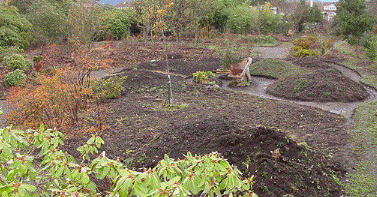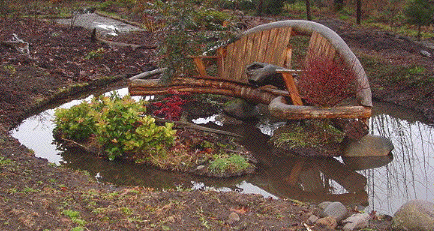By native, we mean native to Washington
and Oregon west of the Cascade Mountains. (A more authentic native
garden would include only plants from the surrounding few miles.)
We are not trying to assemble a massive collection, but rather
to use a few native plants that represent the region and are
aesthetically compatible.
The benefits of a native garden are many.
The plants are attuned to our soils and climate, they need little
care, and they support native wildlife that have evolved with
them. You can find more comprehensive information about regional
plants from the many native plant societies.
Kinnikinnick covers part
of the island, while salal and huckleberry grow in a rotted log
in front of the bench. Oregon grape and vine maple grow through
the openings at each end of the bench. The rest of the garden
has now been planted with the specimens listed in the column
at left.
The simulated glacier river
(later deepened to contain water much of the year) is filled
with river rock and has a snag. Another bench sits atop a hill
behind the photographer, providing a view of the native garden
in the foreground and a backdrop of Mount Rainier and its glaciers,
which produce our local rivers.
 Mount Rainier glaciers,
as seen from the native garden (telephoto)
Mount Rainier glaciers,
as seen from the native garden (telephoto)
By mid-July, it is primarily
glaciers that remain on the windswept mountain above timberline.
Considerable snow is still visible in the foothills on its flanks.




